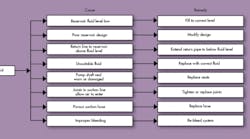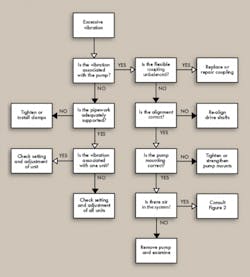It is always important to remember that a hydraulic system consists of many mechanical components. Mechanical components are subject to mechanical problems, vibration being a case in point.
Technically, excessive vibration is a mechanical, not a hydraulic problem. In a well-designed hydraulic system, vibration is neither identified with nor related to the shifting action of hydraulic controls, the linear movement of cylinders, the rotation of pumps and motors, or the oil itself. Yet, mechanical imbalance – which results in vibration – can and often is the cause of hydraulic problems that maintenance people must troubleshoot and deal with. A detailed troubleshooting procedure for excessive vibration appears in Figure 7.
The designer should have anticipated a potential long-term maintenance problem, and not just designed for an easy, short-term assembly solution. A makeshift fix may be a relatively cheap short-term cure, but can become very expensive in the long run.
Don’t keep it a secret — Maintenance personnel should be encouraged to think about causes and prevention of equipment problems, and to communicate their thoughts, observations, and ideas to their company’s management. It is management’s responsibility to review and evaluate suggestions submitted by the maintenance department, and to consider reported design short-comings when planning future equipment purchases. Otherwise, problems are just perpetuated.


